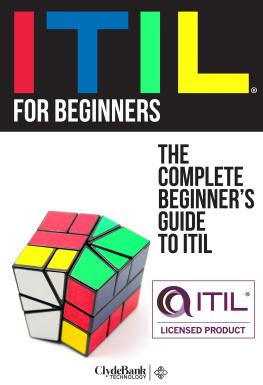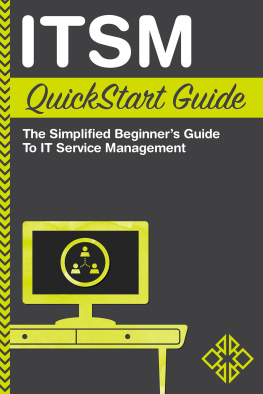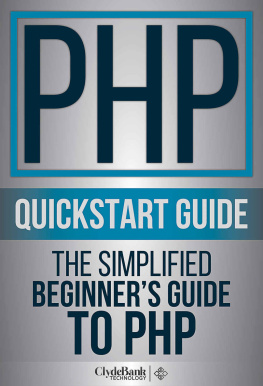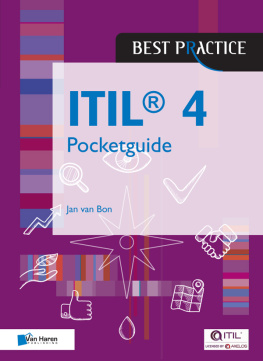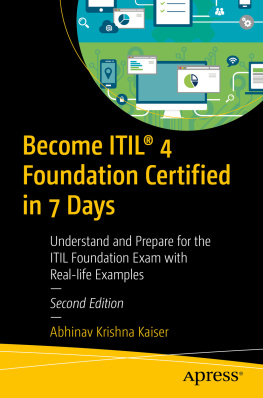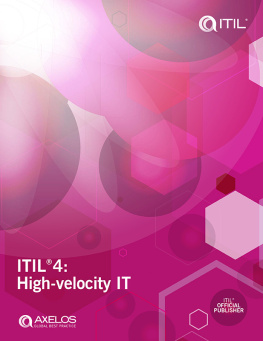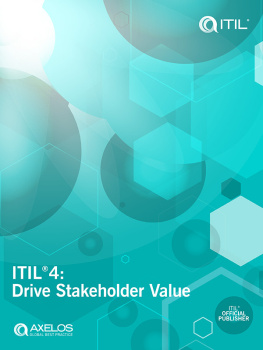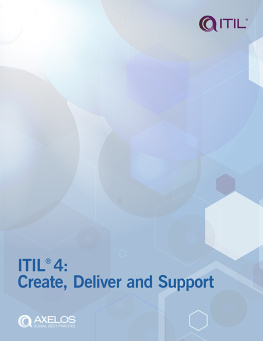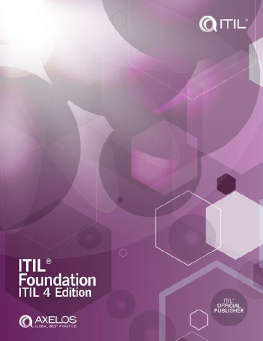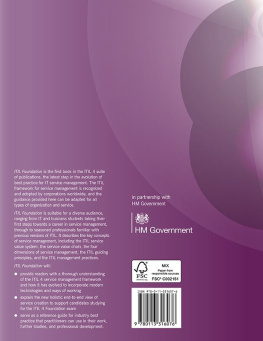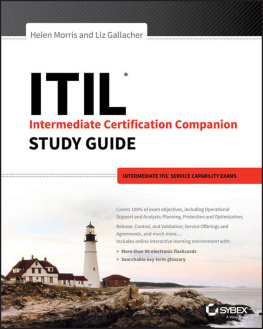Contents
Landmarks
Contents
Terms displayed in bold italic can be found defined in the glossary

BEFORE YOU START READING,
DOWNLOAD YOUR FREE DIGITAL ASSETS!
Visit the URL below to access your free Digital Asset files that are included with the purchase of this book.

DOWNLOAD YOURS HERE:
www.clydebankmedia.com/itil-assets
Introduction
ITIL is a comprehensive collection of best practices for information technology service management. The goal of the Information Technology Infrastructure Library (ITIL) is to optimally calibrate IT departments to function in accordance with the needs of business.
Designing and managing IT solutions (the selection, planning, and delivery of IT services) involves many moving parts with a near-infinite number of pathways of varying expense and efficiency. While creativity and innovation remain valuable attributes in the world of IT, standardization is also extremely important. Consider, for instance, a corporate merger between banks. Troves and troves of sensitive data need to be consolidated. Design work will be required, along with validation and testing. The expense of the integration will need to be addressed and communicated effectively to those overseeing the larger business interests of the parties involved.
When systems need to change, merge, uncouple, or transfer assets between themselves, a uniform and agreed-upon set of robust practices and methods can make these processes intelligible and accessible to all parties involved, on both the technical and the business side.
Simply put, ITIL is a library of universally applicable guidelines and best practices for IT. ITIL is a descriptive framework, not a prescriptive one, which means that it doesnt mandate adherence to particular technologies, hardware, software, or systems.
ITIL provides more what to do guidance and less how to do it instruction. This descriptive approach allows many different varieties of IT organizations to leverage the benefits of ITIL. Organizations domestic or global, public or private, for-profit or nonprofit, from Japan to Saudi Arabia to the United States, use ITIL to tailor IT campaigns to more macro-level organizational objectives and more seamless inter-organizational compatibilities.
A Brief History of ITIL
ITIL represents a community-codified baseline of IT service standards. Conceived in the early 1980s, ITIL came about in a time when data centers were beginning to decentralize. During this time many companies that maintained a multitude of data centers in several different locations found that each hub would, over time, organically develop IT standards and practices highly distinct from one another. This led to poorer and overall inconsistent performance. It was an arm of the government of the United Kingdom, specifically the Central Computer and Telecommunications Agency (CCTA) that first recognized the need for corrective action. At that time varying government centers were running into the same problem. Different centers were creating wholly different IT practices distinct from one another and distinct from those that were found in the private sector. The CCTA began developing the formative tenets of ITIL in the early eighties. To catalog the newly standardized IT practices, a series of books was written, each covering a different dimension of IT management. ITILs first formal iteration, ITIL v1, was initially published in 1989, and successive volumes continued to be published through 1996, with more than thirty ITIL v1 volumes added to the library.
Thirty volumes of best practice proved cumbersome, especially considering that the aim of the ITIL project was to simplify and standardize IT practices. Moreover, purchasing a thirty-volume library is not cheap. In 2000/2001, ITIL v2 debuted with the aim of making ITIL more streamlined and less expensive to implement. ITIL v2 consisted of only nine volumes (called sets) grouped by different aspects of IT applications and services. The two sets that enjoyed the most widespread circulation and application were the Service Support and Service Delivery sets, also known collectively as the Service Management sets.
In May of 2007, Great Britains Office of Government Commerce (OGC), which had absorbed the CCTA in 2001, issued Version 3 of ITIL, known as the ITIL Refresh Project. Version 3 is commonly known as ITIL 2007 Edition or ITIL v3. ITIL v3 condensed the total number of reference volume sets from nine to five.
In 2011, an upgrade to ITIL was published, updating the 2007 version and its five volumes but retaining its fundamental infrastructure. This upgrade is often referred to as the 2011 ITIL upgrade. In addition to being upgraded, 2011 also saw ITIL come under new ownership as intellectual property. Previously owned by the OGC, a bureaucratic office that was absorbed into the British Cabinet Offices Efficiency and Reform Group, ITIL 2011 is technically the property of Her Majestys Government. The Stationary Office (TSO), based in the UK, contracts with the Cabinet Office to print and publish the ITIL books, which can be purchased directly from TSO or from various other resellers.
AXELOSThe ITIL Game Maker *
In July 2013, ITIL ownership was transferred to AXELOS Ltd. AXELOS is a joint venture between Her Majestys (HM) Government and Capita Plc. AXELOS, which has licensed this title youre currently reading and issues licensure to organizations, trainers, and publishers. These licensed organizations can consult, publish books, administer exams and issue formal ITIL certifications. Moreover, AXELOS is charged with keeping ITIL relevant and useful by overseeing the ongoing evolution, modification, expansion, and simplifications of the ITIL framework. AXELOS accredits organizations such as Pink Elephant, which issue specific ITIL certifications. IT professionals from all over the world invest in these certifications in order to build their resumes and to ensure that they remain competitive in the world of modern IT. The most broadly scoped among the many ITIL certifications is the ITIL Foundation level certification , an enormously popular training that many IT professionals have come to regard as an essential resume component.1
Another institution that plays a major role in shaping the evolution of ITIL is the IT Service Management Forum, or ITSMF. ITSMF is a nonprofit membership-based community of IT professionals that meet to discuss and recommend updates and applications for ITIL. There are chapters of ITSMF in almost every country. In larger countries, ITSMF chapters can also be politically influential, as they pursue lobbying efforts to influence public policy.
How to Use This Book
There are no formal prerequisites for learning ITIL. You are not required to have any particular technological proficiency, education, or work experience, but if youre reading this book then it can be safely assumed that you currently work in IT or at least have a serious interest in working in IT in the near future. This book is not designed to provide a singular reference for any specific ITIL certification. Its purpose is to provide readers with an expedient, broad view of the ITIL framework, its applications, and its component parts.
As with any text youll find on ITIL, including the official core and complementary ITIL publications, this text is not to be used as a how-to book for any particular IT system or software. Remember, ITIL is a descriptive, not a prescriptive, framework and its focus is on providing guidance on how to do things, not what to do. It is up to the organization to select specific technologies, hardware, software, apps, middleware, etc. When used as an instrument of guidance, ITIL can be an invaluable aid for effective IT decision making. Technology selection will be the first of many areas where ITIL will help your organization save money by providing services that tightly conform to business objectives.

